Installation of a septic tank topas most
Modern country houses in the absence of a centralized system for the collection and disposal of liquid waste are equipped with local sewage treatment plants. Autonomous systems greatly benefit from cesspools. They can be volatile and non-volatile. It depends on the type of biological waste treatment. Aerobic bacteria multiply when there is oxygen in the contaminated environment. Therefore, the efficiency and speed of processing depend on the uninterrupted operation of the compressor. Topol-Eco company produces Topas septic tanks that respond to any requests for the organization and processing of domestic waste water in the absence of a centralized sewage system. The design and simplicity of the installation process allow the installation of a Septic septic tank by own hands without the help of specialized organizations and the use of technology.
Principle of operation

Before organizing the installation of a septic tank, it is necessary to have an idea of what it is, how it works, what stages of purification and processing are carried out during its operation.
Septic tanks are designed for any type of soil and are designed for any climatic conditions. The compactness of low-end models of installations allows them to fit in a 1.5 1,5 1.5 m pit. The use of aerobic biodegradation technology of organic pollutants increases the level of purification at the output up to 98%, which meets sanitary and environmental standards and regulations.

The first chamber is designed to collect wastewater from the sewer network and primary treatment, which consists in simply settling large fractions at the bottom. When the chamber is filled to a certain level in the first section, the pump starts operating to pump the liquid part of the effluent into the second section, which acts as an aerotank. When the liquid component is saturated with oxygen by means of a compressor, aerobic bacteria rapidly proliferate, splitting organic matter in the effluent into water and the solid fraction (sludge). Then the effluent enters the third chamber, where the liquid is cleaned from sludge. Large particles settle at the bottom, and small and unprocessed ones are sent to the second chamber for additional treatment. In the fourth chamber, the final treatment of sewage takes place up to 98%, after which they can be used for technical needs or disposed of in the soil or gutter.
Features of operation and care
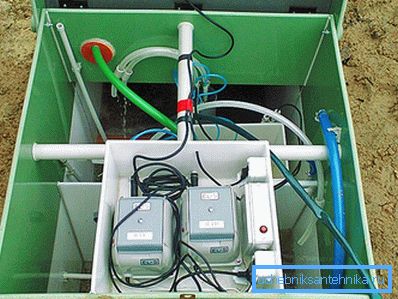
For the operation of the Septic tank, it is necessary to have energy supply for the uninterrupted operation of the pumps and the compressor, as well as warm air for saturation of the effluents with oxygen in order to reproduce aerobic bacteria. Moreover, aerobic bacteria need constant nutrition, otherwise they will die. In other words, the aerobic septic tank is intended only for homes with permanent residence of people.
Reliable and long-term operation of the system depends on compliance with certain rules for the operation and discharge of certain types of waste. Sand, construction debris, rubber and polymer products that are not processed by microorganisms, but cause the clogging of the system, should not enter the sewer system. Do not dispose of drugs, oxidizers, chlorine-containing substances, fuels and lubricants, spoiled vegetables, etc. into the sewage system. as they will kill aerobic bacteria, after which the septic tank will have to be completely cleaned and restarted.
Installation Instructions
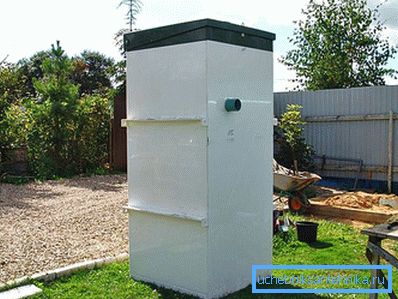
Local autonomous treatment plant should be designed and calculated depending on the binding to the specific conditions of location on the site, climatic conditions, the structure of the soil, the availability of groundwater, etc. The installation site must comply with sanitary and environmental standards. The minimum distance from the septic tank to the house should be at least 5 meters, to the sources of drinking water supply or water bodies from 30 to 50 meters. When placing the sewage system at a distance of 2-3 meters from it should not be vegetation. Sewage pipes should be placed without bends. The depth of their installation together with the septic tank depends on the depth of freezing and the presence of insulation of the sewerage network and the treatment plant.

On the horizontally aligned platform of the pit lower the septic tank. The weight of small models of installation exceeds 200 kg. With this work, you can handle manually with assistants (3-4 people) or order the services of special equipment. Manual installation is carried out with the help of cables that can be threaded through special holes in stiffeners. The septic tank is leveled at the site by level.
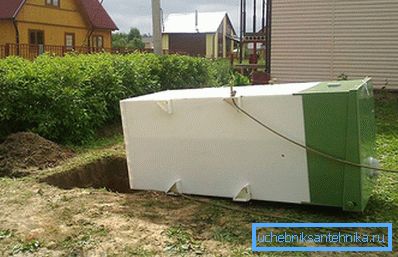
The trenches are laid sewer pipes with the necessary slope. The slope depends on the diameter of the pipe. The pipe is attached to the inlet and sealed. The place of insertion is determined by taking into account the depth of the pipe and the septic tank. The distance from the level of the ground surface to the tapping point of 70–80 cm should be maintained. Sealing is carried out using a special polypropylene cord and a building hair dryer. The joint turns soldered. They also equip the outlet drain from the septic tank into the filtration field or into the ditch. At shallow laying of the pipeline network, a heater is used to protect against frost penetration.
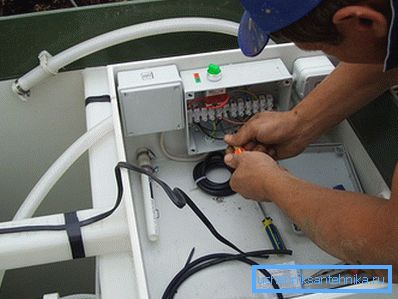
Power supply is provided by laying an electric cable laid in a corrugated protective tube. The cable is laid in the same trench as the sewer network. Connect the cable to the special terminals on the septic tank. The power supply of the septic tank is carried out through a separate protective automat in the electrical panel of the house.
Having checked the connection of all engineering networks, they carry out the backfilling of the septic tank in layers of 20–30 cm. At the same time, the capacity of the septic tank should be filled with water to equalize the pressure of the grant. Having filled up and, if necessary, warming the trench and the pit with a septic tank, start the installation into operation, according to the instructions.
For clarity, all the processes of installation and installation of a local sewage treatment plant Topas can be viewed on the video.
Maintenance
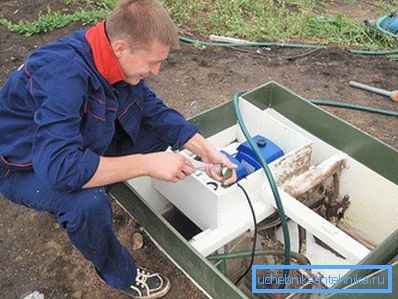
Maintenance of the septic tank should be carried out according to the instruction manual attached to the septic tank.
The service life of the installation can reach 50 years with all the conditions of installation, operation and maintenance. Since the purification technology is based on the use of microorganisms, any violation of the process of their reproduction will lead to the cessation of biological waste treatment. To avoid such situations, it is necessary to observe the following conditions:
- The deep filter must be cleaned once a month.
- The compressor membrane should be replaced at least once every 2–3 years.
- The accumulated sludge should be pumped out with a drainage or fecal pump at least once a year (depending on the filling). Silt is a fertilizer, it can be pumped to the beds.
- With a frequency of once every 10 years, carry out a full cleaning of the septic tank with the replacement of the entire aeration system.
Video
Watch the video tutorial, which shows how to install the Tapas septic tank with your own hands: